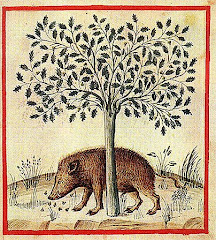I'm so pleased to have my first handful of visitors to this blog, and even more pleased that such encouraging comments have been left. As an example, regarding my pine bark extract post a few days back, Sarah said:
"Now having tantalised us with this information about pine and pain relief, you do realise you're going to have to make some salve and try it out on someone and let us know how it works!"What a wonderful prompt for my next project! Unfortunately, not only do I not know how to make an effective pine salve, but I'm also rather short of healthy happy pine trees in this part of deciduous S. Wales. Aside from that, my only guinea pig is me since even my partner won't try most of my experiments. Should I say unfortunately I don't have arthritis? I don't think I'll go quite that far.
Instead, I'll cheat since I just happen to have a small tub of pine salve already! Not made by me I'll admit, but bought from a tiny community in northern Sweden.

And this leads me on to Sarah's next comment:
"Pine isn't something I've worked with nor felt drawn to, but I am about to try some meadowsweet salve which Henriette recommended recently on her blog."
It is so important, as Sarah says, to feel drawn to a plant when working with it. I find that once I know a plant intimately, have seen it grow in every season, have tasted it in a variety of contexts, have maybe held its seeds in my hand, that that is the point at which I may be capable of learning and remembering how to use it and developing some kind of instinct for it. It's no surprise then that most people in the UK haven't adopted Pine as a primary medicinal resource when in many areas they are so few and far between.
But then, it is winter, a time when people in more Northern climes may have relied on the medicinal properties of Pinus more than we give it credit for. And since Sweden is so close to my heart and so abundant with pine trees, I thought maybe the blog-flavour (if you can have such a thing) of this last month of winter should actually be pine, so that I at least can take the opportunity to get to know it better and appreciate it more.
So, back to my salve. The charmingly home printed label translates roughly as "Genuine olden-days resin-salve from Skalmsjö". I have no idea exactly what's in it, but it smells beautifully warm and rounded with equally prominent scents of pine and beeswax. Rather surprisingly, this sort of salve isn't seen often in Sweden these days, a country so determined to look towards the future in some respects that it is hard to say what survives of any herbal traditions at all. This one was bought from the tea rooms which support an old linen mill where such produts help to raise maintenance funds. It's a beautiful place, and my goodness, there's no shortage of pine trees there. Pine is their number one resource!
Back to the salve again: I don't know what it would have been traditionally used for either. Arthritis? Maybe. The only thing I've used it for so far is mosquito bites. And I have to say it was surprisingly effective. If it's ability to soothe my bites, which I have a habit of scratching holes in, is anything to go by, the most obvious traditional Swedish use must have been just that. Besides, the frequency with which pine trees and mosquitos seem to go together must make this salve a very sympathetic magic. And I mean that literally.
So that's my pine salve. It sits on my shelf of goodies and is rarely used, probably because, as mentioned above, I have no instinct for it yet so I forget it's there (and maybe also because it's special and I'm a chronic hoarder). I will definitely take it with me to Sweden this summer, but now I think I'll try to bear its other potential uses in mind as well and when I've found out more about it I'll let you know.




















2 comments:
Lovely post, Kristina!
My recollections of discussions by pine users on Henriette's blog usually range around steeping the needles for a warming/soothing/vitamin rich tea during winter and using the resin for sealing burns. Someone once sent me some pine resin from Nova Scotia and I foolishly tried to make a tincture with it, before I discovered you can't extract it in alcohol! It's still sitting on one of my larder shelves "just in case" it might come in handy! (I, too, am a terrible hoarder!)
Resins need to be extracted in 95 % alcohol.
Pine salves are exceedingly nice on any kings of scratches, small wounds, bites - and yes, they're also nice for things like arthritis and psoriasis.
Me, I recently made another batch of tar salve. Mmmm. That scent! Same use as pine salve -- a friend gave some to a friend with blisters on the feet, which healed in no time at all, so she wanted half a dozen more jars. Heh.
Sarah, you gave me an idea: I'll give a pine needle salve a twirl. Should be nice.
Post a Comment